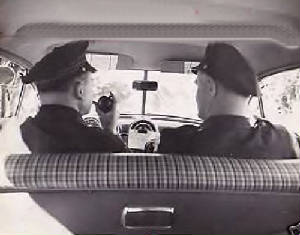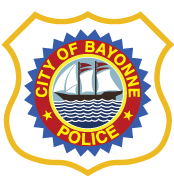History of the BPD
1661
Early Law Enforcement in Bergen Township
Governor Stuyvesant was the ruling power of Bergen Township among other sections of New Jersey, in the year 1661. Bergen Township included that territory between the present Journal Square and the Kill Van Kull, which separates Bayonne from Staten Island. It was the Governors duty to appoint a Justice of the Peace who was assisted by three constables. The Justice of the Peace affected the operations of the law. The constable was a high officer of state in medieval courts. He was the policeman in the days of Stuyvesant and operated, as did the English constable. The Justice of the Peace heard matters brought to his attention by the constables. Basically, the spirit of these police functions is being carried out today though they have been modernized to fit the times.
1861
The Birth of Bayonne and Early Policing
Bayonne, as such, was born on April 8, 1861. Prior to that date, the area was known as Bergen Neck, whose appointed Justice of the Peace was a man named Francis Miller. When Bayonne first became independent, part of the governmental plan was to elect a Justice of the Peace. Francis Miller ran for that office and was elected. His duties as director of the three constables continued much the same as prior to his election.
1869
Formation of the Bayonne Police Department
The Bayonne Police Department was born in 1869 in Twomey’s Hall, a two-story frame building, which stood at 9 Dodge Street. The police force was created by ordinance on September 6, 1869. Originally appointments consisted of one patrolman from each ward. The first three patrolmen were Thomas Connelly, Jack Van Pelt, and Hartman Vreeland. One year later, on September 6, 1870, George B. Whitney was named as Chief of Police of the already formed police department. Four additional patrolmen were named at that time. They were Arthur Cavanaugh, Cornelius Van Horn, Michael Connelly, and Michael McNamara.
1870
Appointment of the First Police Chief
Several years after its inception the police department abandoned the Dodge Street structure and moved into a two-story framed building at Twenty Second Street and Broadway, which was then city hall. Between 1869 and the late 1890s the department acquired room in three fire houses in the city for police sub-stations where patrolman locked up their prisoners until they could be taken to the jail. These stations were located at 50th. Street and Broadway, 7th. Street and Broadway, and 22nd. Street and Maiden Lane near the Hook. In 1893 a new city hall was constructed at 30th. Street and Avenue “E.” The police headquarters and jail were shifted into that building, and the former headquarters at 22nd. Street and Broadway was made a precinct station. Centralization of the department was realized in 1905 when the municipal building at 26th. Street was erected, and the police force moved in.
1892
The Introduction of Detectives
On March 18, 1892, an ordinance was passed which provided for the assignment of a member of the police force to detective duty. Patrolman Edward M. Griffin was the first detective of the Bayonne Police Department. He was promoted to Sergeant in 1903. The Detective Bureau, under the immediate supervision of the Detective Sergeant, was created by an amendment on October 4, 1910. The same amending order established a branch of the Detective Bureau known as the Bureau of Identification, also under the Detective Sergeant. This arm was charged with keeping records of criminals through utilization of the Bertillion system, fingerprinting methods, and photography. In 1917, eight patrolmen were assigned to the Detective Bureau as acting Detectives. As time passed on, additional personnel and supervisors were assigned to detective duties as investigative responsibilities increased.
1902-1905
Police Uniforms, Substations, and Headquarters
The regulation uniform of the original department included a British style helmet, blue trousers, and a blue coat, which extended to slightly below the knees. The officers were also armed and regimented to a schedule. They were assigned to all public functions, and their primary duties concerned peace preservation. Whether it was in the days of the Roman warrior, the Indian brave, the English constable, or the American policeman, the citizens of all communities relied upon these select groups for protection from wrong-doers. Foot power was the only means of transportation used by the police until the 1890s when mounted patrolmen and a horse-drawn paddy wagon were introduced to the force. Policemen used to walk to the jail, which was also housed in Twomey’s Hall. They were often forced to solicit the aid of a passerby in persuading a recalcitrant lawbreaker.
1907
Technological Advancements in Policing
Early in the 1900s, the Gamewell Police Telephone System (police callboxes) was introduced, resulting in the abandonment of the substations since patrolmen could call the van as soon as they caught a lawbreaker. These callboxes served the police department until the 1970s. In 1907, the department kept up with the transportation of the times by assigning policemen to bicycle duty to apprehend speeding cyclists. An ordinance on December 21, 1907, also set forth rules for the government and control of the force. Patrolman Martin Kavanaugh was Bayonne’s first bicycle policeman.
1908-1917
Reorganization and Growth of the Police Force
On January 8, 1908, an ordinance establishing the title of Inspector of Police, then second in command of the department, was instituted. The first Police Inspector was Edward M. Griffin. On July 3, 1912, seven Sergeant positions were created by municipal ordinance. The office of Captain of Detectives and the appointment of seven Lieutenants of Police were created by an amendment on December 3, 1913.
1920s
Increased Supervision and Specialization
By 1919, the police force consisted of one Chief, one Inspector, two Captains, thirteen Lieutenants, six Detectives, and one hundred and ten Patrolmen. Prior to this time, the automobile had replaced the bicycle for mobile patrol. The population by this time was 77,000, and by 1926, the city had 91,000 inhabitants. The demands on the police department increased rapidly.
In 1927, another police manual was adopted. The new table of organization included one Chief, one Deputy Chief, one Inspector, Captains, Captain of Detectives, Superintendent of Criminal Identification, Lieutenants, a Detective Sergeant, Sergeants, Detectives, Patrolmen, Police Women and such other officers and employees as may from time to time be appointed. The force now numbered over two hundred men and two policewomen. On January 8, 1924Lillian Hanon was the first female appointed to the department. This position was an investigative duty and the officer did not carry a gun. On April 15, 1925 Margaret Doyle was appointed as a second policewoman. On September 21, 1926 Emily Hassmiller was appointed to replace Officer Hannon, who resigned. In 1933 one female position was discontinued. This left Officer Hassmiller who served with the department until her demise in 1949. Peggy Burt was the last female investigator appointed. She served from 1949 until her retirement in 1976.


1930s
Motorized Patrols and Improved Communication
In the 1930s more and more motor vehicles were appearing on the public highways. City streets were being improved, and it was necessary to enlarge the police mobile force so that it had increased from a mere two patrol car system to a five patrol car system, and the Bayonne Police Department now had twenty-five motorized vehicles, both marked and unmarked. Communications developed through the use of the telephone and radio. Bayonne, in 1933, gained prominence by being the first city to use a two-way radio system in police cars. Other municipalities had receiving sets installed in their patrol cars, but at that time only Bayonne had patrol cars that could receive and transmit messages. This system greatly improved police services and was detrimental to violators of the law. The department received national attention and praise for this significant improvement in police communications.
1945
Post-War Growth and New Divisions
In 1945, the department had grown to a total strength of 219 personnel. Its motorized equipment consisted of ten radio cars, seventeen motorcycles, two patrol vans, a police ambulance, and several unmarked cars for special assignments. It was also in 1945 that the Juvenile Bureau was established within the department. In 1947, the Police Athletic League (PAL) headquarters was formed in the Corwin building, located at Twenty-Fourth Street and Avenue “A”. This building was used for teenage sporting activities until the 1990s. The objective of the PAL was to combat juvenile delinquency through a program of sound recreational activities to develop good character and a sense of responsibility.
1962
Modernization and the Introduction of Specialized Units
In 1962, the authorized strength of the police department was 189 sworn members, which included one Chief, one Deputy Chief, one Inspector, nine Captains, seventeen Lieutenants, and fifteen Sergeants. On April 27, 1962, the department’s first indoor pistol range was officially opened. It was located in the Sixteenth Street Park. It was built by the officers themselves with financial assistance from the local PBA and local business merchants. In 1964, a new police manual was implemented. It outlined the duties and responsibilities of all members of the department. In addition, new specialized units were enhanced, such as the Gambling Squad, Alcohol, Beverage and Control Squad, Narcotics, and the Juvenile Aid Bureau. These units were of great assistance in helping to solve complex problems of that era. The department was also increased from one Inspector to two Inspectors, nine Captains to ten Captains, and fifteen Sergeants to seventeen Sergeants. This was also the period when Bayonne was again a first in its use of police walkie-talkies, both to transmit and receive.
1972
The Move to a New Police Command Center
In May of 1972, the police department moved out of the old police headquarters, which was built in 1905, into a new modern police command center. The new facility was built between Twenty-Seventh and Twenty-Eighth Streets on Avenue C as part of a large municipal service complex. At this time, the department consisted of 194 sworn officers, which included one Chief, two Deputy Chiefs, ten Captains, seventeen Lieutenants, seventeen Sergeants, and 147 Police Officers.
1982
A Comprehensive Police Manual and New Procedures
In 1982, an in-depth police manual was developed. It not only included duties and responsibilities, rules and regulations, and uniform requirements, but it also instituted standard operating procedures and in-service training bulletins that would guide the police officer in performing his duties and keep him or her abreast of changes in the law or department policy.
1989
Entering the Computer Age
In 1989, the department started to enter the computer technology age. A computer-aided dispatch system was instituted. This technology greatly improved the department’s response to calls for service. During this period, a complete audit of the agency was conducted to show ways of running the organization more effectively. In the early 1990s, as part of a department reorganization project, civilian dispatchers were added to the department to make more sworn officers available for street patrol. The supervisory ranks, as well as the overall number of sworn police officers, were streamlined to make the agency more cost-effective. In addition, the purchase of computer terminals replaced the typewriter. This state-of-the-art equipment vastly enhanced the department’s administrative abilities. As a result of the streamlining process, as well as the increased use of civilian personnel, the total strength of sworn police officers in the department was lowered to 169 members.
1990s
Technological Advancements and Department Reorganization
In the mid-1990s, as a result of federal grant monies, civilian employees took over the position of Police Desk Clerk. More police officers were added to the department to supplement such programs as Community Oriented Policing, Cops in School, and Drug Abuse Resistance Education (DARE). A new mobile command center, fully equipped with modern communications, was purchased. Mobile data terminals were added to the police patrol vehicles, giving officers in the field the ability to process report writing through the use of computers. In 1999, a complete audit of the agency was conducted again, in part because of a large increase in sworn personnel.
2002
A New Communication Center
In March of 2002, a new communication center was installed in police headquarters. It included the most advanced technology available for receiving and tracking communications and personnel. It also dispatches fire services as well as police services. Twenty communication center personnel and one supervisor manned five consoles, rather than the three consoles used in the past. In 2003, police sergeants were assigned to the communications center as supervisors.
Present Day
A Modernized Bayonne Police Department
Over the years, the Bayonne Police Department developed into a modern law enforcement and service-oriented agency. Today’s police officer is better trained, better educated, and better equipped than his predecessors. New recruits are mandated to complete a 17-week Basic Police Training Course. In-service training schools are scheduled for officers as they progress through their careers. Examples of in-service training include computer operation, radar operation, criminal investigation, sex crime investigation, auto theft investigation, missing person investigation, hostage negotiation, evidence collection techniques, crime prevention techniques, community-oriented policing, and drug abuse resistance education (DARE).
Since the institution of the Bayonne Police Department in September 1869, over 1,100 officers have been appointed to the organization. Twenty police chiefs have served during this time.

Guided by Honor, Service & Duty
Bayonne Police Headquarters
630 Avenue C, 2nd Floor Bayonne, New Jersey 07002
Telephone Numbers
MAIN
201-858-6900
Investigations
201-858-6925
Juvenile Division
201-858-5855
Cops in Schools
201-858-5856
Animal Abuse
201-858-6900
Records
201-858-6944
Project Lifesaver
201-360-7706
ABC/Firearms
201-858-6939
Traffic Division
201-858-6969
Internal Affairs
201-858-6911


